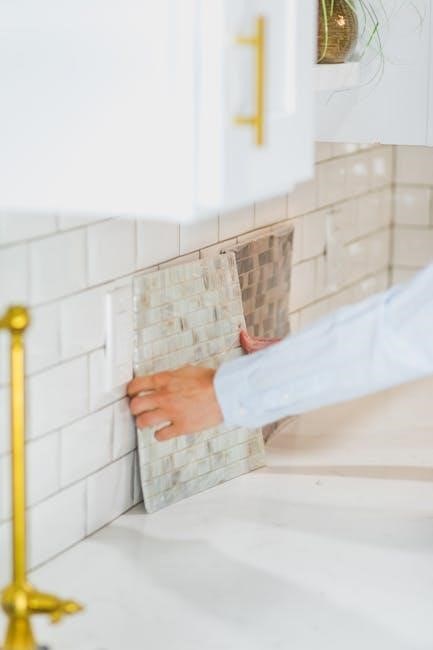How to Clean a Self-Cleaning Oven Manually
Turn off and unplug the oven, allowing it to cool completely․ Remove racks and shelves for separate cleaning․ Apply a baking soda paste or vinegar solution to tough stains, let sit overnight, then wipe clean with a damp cloth for a sparkling finish․
Manual cleaning of a self-cleaning oven is a practical approach for maintaining its hygiene without relying solely on the self-cleaning feature․ This method is ideal for lighter messes or for those who prefer eco-friendly solutions․ By using natural ingredients like baking soda and vinegar, you can effectively tackle tough stains and grime․ The process involves creating a paste from baking soda and water, applying it to the interior, and letting it sit overnight to break down stubborn residues․ A vinegar solution can then be used to dissolve grease and food particles, followed by a thorough wipe-down with a damp cloth․ This gentle yet effective technique not only preserves the oven’s finish but also aligns with environmentally conscious cleaning practices․ Regular manual cleaning can complement the self-cleaning function, ensuring your oven remains in optimal condition․
Understanding the Self-Cleaning Feature and Its Limitations
A self-cleaning oven is designed to burn off food residue at high temperatures, leaving a light ash that is easy to wipe away․ While this feature is convenient, it has limitations․ The self-cleaning cycle can take several hours, produces strong fumes, and may not handle large spills or heavy buildup effectively․ Additionally, the extreme heat can damage racks or create harmful emissions․ Manual cleaning is often necessary for lighter messes, delicate surfaces, or when the self-cleaning function isn’t enough․ It’s also a safer, chemical-free alternative for maintaining the oven’s interior․ Understanding these limitations helps homeowners decide when to use the self-cleaning feature versus manual methods, ensuring the oven remains clean and functional without unnecessary wear․

Preparation Steps for Manual Cleaning
Turn off the oven, let it cool completely, and unplug it․ Remove racks and shelves for separate cleaning․ This ensures safety and makes the cleaning process more efficient and accessible․
Turning Off and Cooling the Oven
Before starting manual cleaning, ensure the oven is completely turned off and unplugged․ Allow it to cool down thoroughly to avoid burns or damage․ This step ensures safety and prevents accidental start-ups․ Open a window for ventilation to eliminate any lingering fumes․ Letting the oven cool makes surfaces easier to clean and avoids warping or cracking from sudden temperature changes․ Once cooled, proceed with removing racks and shelves for a deeper clean․ Patience here ensures a smooth and effective cleaning process without risking injury or damage to the appliance․ Always prioritize safety and proper preparation when handling oven cleaning tasks․ This initial step sets the stage for a successful manual cleaning experience․ Proper cooling also helps in preventing any chemical reactions during cleaning․ Ensure no heat remains before proceeding further․ This precaution is crucial for both effectiveness and safety reasons․ Always follow this step diligently for optimal results․
Removing Oven Racks and Shelves
Start by turning off and unplugging the oven to ensure safety․ Once cooled, carefully remove all oven racks and shelves to prevent damage during cleaning․ This step allows for easier access to the oven interior and prevents residue from baking onto the racks․ Gently lift each rack and place them in a sink or large container for separate cleaning․ For tougher stains, soak the racks in warm soapy water or a mixture of baking soda and water․ Avoid using abrasive materials or harsh chemicals to prevent scratching․ After cleaning, dry the racks thoroughly and store them safely until reinstallation․ Proper removal and cleaning of racks and shelves ensure a more effective and efficient manual cleaning process․ This step is essential for maintaining the oven’s overall hygiene and functionality․ Always handle racks with care to avoid accidental damage or injury․

Cleaning Methods and Techniques
Use a baking soda and water paste for tough stains, a vinegar solution for grime, or lemon juice with steam for a natural cleaning alternative․
Using Baking Soda and Water Paste for Tough Stains
Create a paste by mixing 1 cup of baking soda with 3 tablespoons of water․ Apply the paste to interior surfaces, focusing on stained areas․ Let it sit overnight․ After 12–24 hours, use a damp cloth to wipe away the paste and grime․ For stubborn stains, allow the paste to sit longer before scrubbing gently with a non-abrasive sponge․ Rinse thoroughly with warm water and dry the surfaces with a soft cloth to prevent streaks․ This method is eco-friendly and effective for breaking down tough grease and food residue without harsh chemicals․
Applying a Vinegar and Water Solution
Mix equal parts of white vinegar and water in a spray bottle․ Shake well to combine․ Spray the solution onto the interior surfaces of the oven, focusing on areas with heavy grime or stains․ Allow the solution to sit for about an hour to help break down tough residue․ Use a soft, damp cloth to wipe down the surfaces, working in a gentle circular motion․ For stubborn spots, let the solution sit longer before scrubbing lightly with a non-abrasive sponge․ Avoid using abrasive materials to prevent scratching the oven’s finish․ Rinse the cloth frequently and continue wiping until the surfaces are clean․ Finally, use a dry microfiber cloth to remove any excess moisture and prevent streaks․ This method is gentle yet effective for maintaining a clean oven without harsh chemicals․

Utilizing Lemon Juice and Steam for Natural Cleaning
To clean your self-cleaning oven using lemon juice and steam, start by mixing equal parts lemon juice and water in an oven-safe bowl․ Place the bowl on the middle rack of the oven and heat it to 250°F (120°C) for 45-60 minutes․ The steam from the lemon mixture will help loosen grease and grime on the oven walls and floor․ After the oven cools, use a damp microfiber cloth to wipe down the surfaces, working in a gentle circular motion․ For tougher stains, let the mixture steam for an additional 15-20 minutes․ This method is eco-friendly and leaves a fresh, citrus scent․ Avoid using abrasive scrubbers to protect the oven’s finish․ Repeat if necessary for heavily soiled areas․ This natural cleaning technique is effective and chemical-free, making it ideal for routine maintenance and deep cleans alike․

Maintenance and Tips for Long-Term Oven Care
Regularly wipe down the oven after use to prevent grease buildup․ Avoid harsh chemicals and abrasive materials to protect the finish․ Use non-toxic solutions like baking soda or vinegar for natural cleaning and maintenance․
Regular Wipe Downs to Prevent Grease Buildup
Regular wipe downs are essential to maintain your self-cleaning oven’s efficiency․ After each use, allow the oven to cool slightly before wiping down the interior with a damp microfiber cloth․ This simple step prevents grease and food residue from hardening, making future cleaning easier․ For tougher spots, mix a solution of mild dish soap and warm water, and gently scrub the area․ Avoid using abrasive materials or harsh chemicals, as they can damage the oven’s finish․ Consistent maintenance ensures the self-cleaning feature works effectively and reduces the need for deep cleaning․ By incorporating this routine, you preserve the oven’s performance and extend its lifespan․
Avoiding Harsh Chemicals and Abrasive Materials
Avoid using harsh chemicals or abrasive materials when cleaning your self-cleaning oven, as they can damage the interior surfaces or interfere with the self-cleaning function․ Instead, opt for gentle cleaning solutions like a mixture of baking soda and water or a vinegar and water solution․ These natural alternatives effectively tackle tough stains without causing harm․ Always use a soft-bristled brush or a microfiber cloth to avoid scratching the oven walls or floor․ For particularly stubborn stains, apply the cleaning solution and let it sit before wiping clean․ This approach ensures the oven remains in optimal condition and retains its self-cleaning efficiency․
Additionally, never use steam cleaners or abrasive scrubbers, as they can compromise the oven’s finish․ Regularly cleaning with gentle methods prevents the need for aggressive products, keeping your oven maintained and functioning smoothly for years to come․

